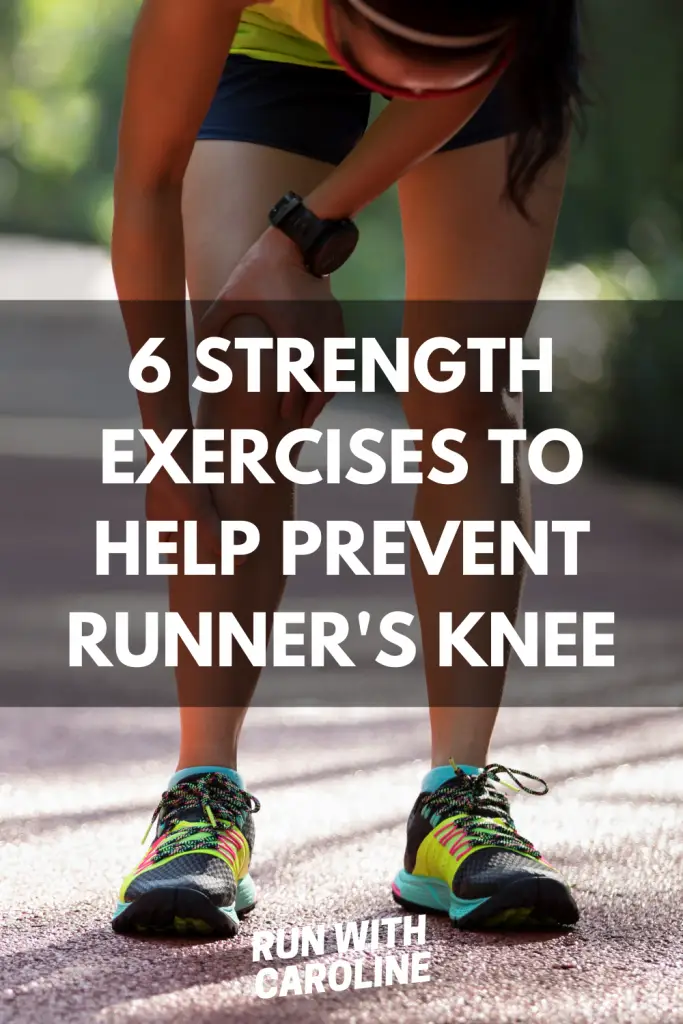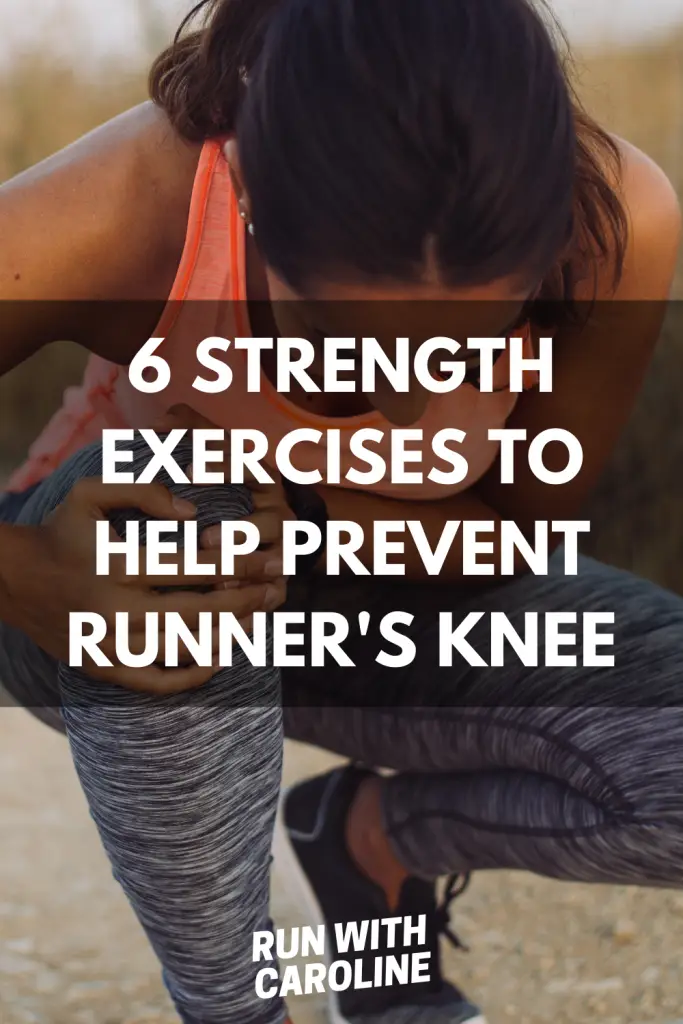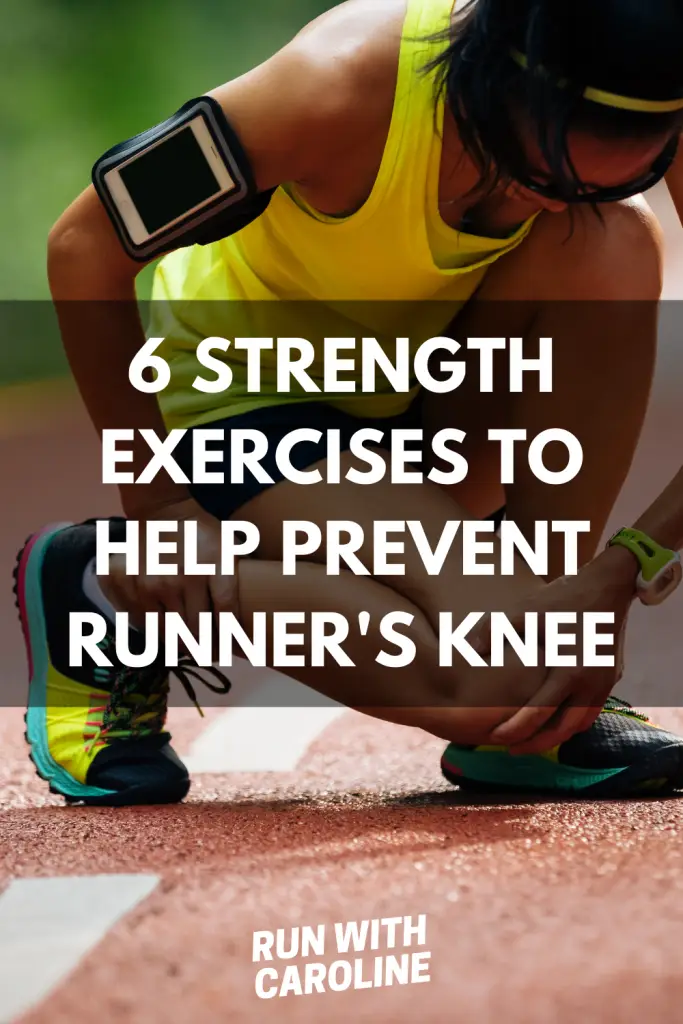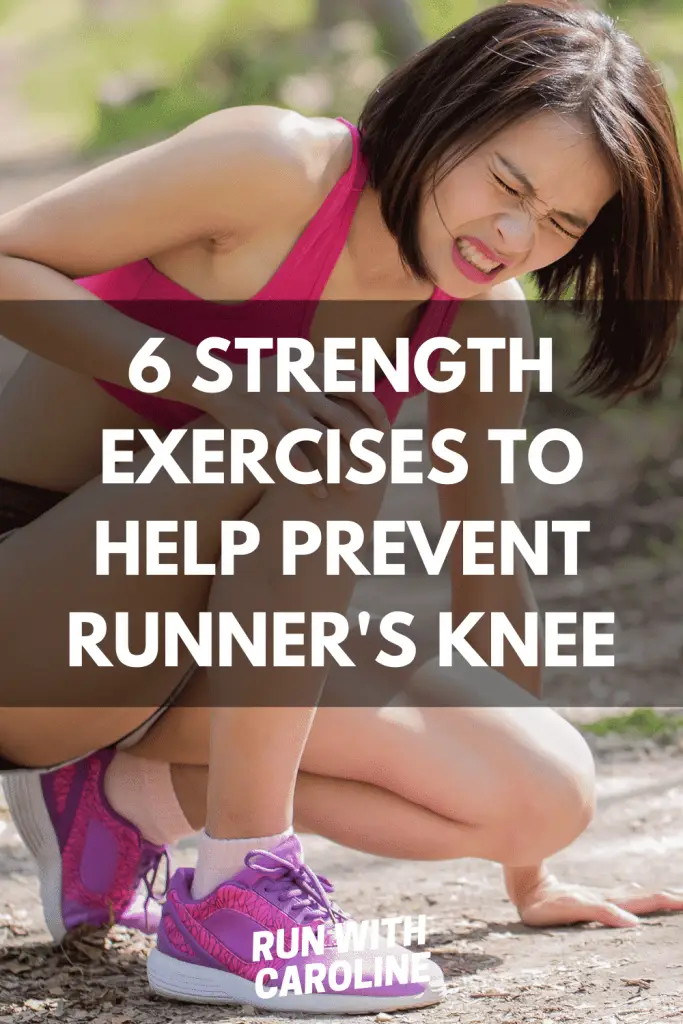Runner’s knee is a typical overuse injury and is one of the most common running injuries in the running community.
It normally involves pain at the front of the knee and mainly affects teenagers and physically active people like runners.
The pain can develop differently over time.
According to research, about half of those affected only have pain for a few weeks or manage to get it under control within a few months.
In the other half, the pain can become more chronic and last for several years or keeps coming back.
If you think you have runner’s knee, then do not worry!
There are ways to treat it and prevent the condition from getting any worse, and prevent it from returning in the future.
In this guide we’ll explore:
- What is runner’s knee?
- What are the symptoms of runner’s knee?
- What are the main causes of runner’s knee?
- Can runner’s knee be reversed?
- How to fix runner’s knee
- How to treat runner’s knee
- 6 strength exercises to help prevent runner’s knee
Ready?
Let’s go!

What is runner’s knee?
Runner’s knee is one of the most common running injuries – it can develop in beginner, intermediate and advanced runners alike.
Runner’s knee doesn’t mean structural damage to the knee cap.
It is more to do with the muscles in your knee and how they function day to day through repeated movement.
Every time you take your stride and flex your knee, you add impact to your knee as you move your foot forward, which causes the pain.
If the mechanics in your body are off, this can also make the pain worse.
It causes pain behind, in front and around the knee cap. Pain at the front of the knee usually occurs just behind or next to the knee cap.
This is also known as patellofemoral pain or patellofemoral pain syndrome (PFPS).
Related: IT band syndrome: Treatment, symptoms and exercises
What are the symptoms of runner’s knee?
The main symptom of runner’s knee is pain at the front of the knee.
This pain and discomfort normally intensifies when you do certain activities or movements such as climbing stairs or sitting for long periods of time.
Here is a full list of runner’s knee symptoms:
- Pain at the front of the knee
- Dull ache around the knee cap
- Discomfort immediately after running
- Pain that intensifies when you squat or climb stairs
- Pain that intensifies after sitting for a long period of time
- Clicking, grinding or rubbing sound when you bend and straighten your knee
Related: Shin splints when running: Exercises, symptoms and treatment

What are the main causes of runner’s knee?
One of the main risk factors with runner’s knee is overuse.
Activities like running and cycling that put a lot of strain on the front of the knee are more likely to cause runner’s knee.
Overuse is more likely to occur if you run too much or you take sudden jumps in your training.
Another common cause of runner’s knee is abnormalities above and below the knee cap.
This means the knee has to cope with a lot more weight and pressure, which causes it to malfunction and thus cause the pain.
Here are common causes of runner’s knee:
- Weak hips
- Weak quads
- Improper footstrike
- Low cadence
- Poor flexibility
- Poor foot support or ill fitting running shoes
- Overuse through intense training
- Sudden jumps in training
- Trauma or injury to the knee
Related: 4 ways to improve running cadence
Can runner’s knee be reversed?
Unfortunately, runner’s knee is not something that will disappear on its own.
If you develop runner’s knee, it normally means you need to reduce your mileage or give up running all together whilst you let your knee recover.
During your recovery phase, it’s wise to focus on building your flexibility and muscle strength to counteract any muscle imbalances.
Focus on strength exercises that target the large muscles of the legs such as the glutes, hip adductors, quadriceps and hamstrings.
These muscles are important for knee rehab.
At the end of this guide you will find the 6 strength exercises to help prevent runner’s knee.
These can be used during your recovery phase.
Related: 5 tips for returning to running after an injury

How to fix runner’s knee
Here are a few ways to fix and prevent runner’s knee.
#1 Strength train
Strength training is a vital part of becoming a better and stronger runner and, indeed, for runner’s knee recovery.
As weak hips and lazy glutes are common causes of runner’s knee, strength exercises that target muscles to help align your hips and knees are recommended.
According to a 2020 study, regularly doing exercises to help prevent runner’s knee can relieve the pain and improve the joint function.
These exercises can be purely bodyweight exercises or you can add weights or a resistance band to add resistance and make them a bit more challenging.
#2 Wear the right running shoes
A good, well-fitted pair of running shoes and working on your running form will also go a long way to help prevent runner’s knee in the medium to long term.
Research has shown that a whopping 4 out of 5 runners wear running shoes that don’t suit their running style.
Running shoes have two key functions:
- Absorb the shock when your foot lands on the ground (this is called cushioning).
- Encourage your feet to move in a safe and efficient manner through running gait.
When finding the right pair of running shoes, it pays to shop around!
Head to your local running shoe store, preferably one that offers a free gait analysis service.
This is because you are more likely to get the best support and advice you need when buying running shoes.
You can find more information in my guide on how to find the right running shoes.
#3 Fix your footstrike
Your footstrike is essentially how your foot hits the ground when you run.
There are three main types of footstrike:
- Heel strike – this is when your heel hits the ground first.
- Mid-foot strike – this is when the middle of your foot hits the ground first.
- Forefoot strike – this is when the ball of your foot hits the ground first.
Runners who overstride tend to hit the ground with their heel first (also known as ‘heel strike’) and with more force.
This puts extra pressure on their heels, knees, muscles and joints. Over time this can lead to strain and injury.
This is why the mid-foot footstrike is the preferred footstrike when it comes to reducing the rate of injury.
With this footstrike, the middle of your foot hits the ground first therefore distributing your weight more evenly through your foot and ankle when you run.
Mid-foot strike running causes the least stress on the muscles and joints in your feet and legs.
It therefore helps to reduce the rate at which impact forces travel up the leg and decreases your risk of injury.
The key takeaway? Try and adopt a mid-foot strike when you run.
#4 Increase your cadence
Running cadence is the amount of steps you take per minute (SPM) when you run.
Cadence is a key part of proper running form and has even been shown to reduce the rate of injury.
Studies have shown a cadence of 170 SPM is the optimal running cadence for running performance and injury prevention.
If you have a low cadence, you will likely have a long stride.
As we saw when describing footstrike above, overstriding puts more stress and pressure on your muscles and joints and heightens the risk of injury.
Try and adopt a high cadence when you run. You can read more about cadence in my running cadence guide.
#5 Avoid sudden jumps or changes in your training
As part of any well-rounded training plan, you will see a gradual increase in weekly mileage.
The general rule of thumb, depending on the distance you are training for, there should be a 5-10% increase each week.
If you take sudden jumps in mileage, this can increase the risk of injury.
Instead, make changes to your training plan incrementally.
#6 Stretch
Stretching can do wonders for your running performance and running form.
A regular stretching routine as part of a warm up before a run or standalone session will help to improve flexibility and mobility and prevent irritation in the knee.
Focus on doing dynamic exercises in your pre-run warm up and static stretches in your post-run cool down.
Related: The 9 best pre-run stretches (and how to do them properly)
How to treat runner’s knee
Runner’s knee can be successfully treated at home as soon as you start to feel pain or discomfort in your knee.
The first step in a treatment action plan is to stop running and rest your knee. This is important to avoid any further pain and discomfort.
You’ll then want to take the following steps:
- Apply an ice pack to your knee. This will help to reduce any inflammation and swelling. Apply an ice pack or a frozen bag of peas for up to 30 minutes at a time. Avoid applying heat to the affected area.
- Compress your knee. This will help to restrict any swelling. You can do this by wrapping your knee in an elastic bandage. Be careful though not wrap your knee too tightly.
- Elevate your knee. This will help to prevent further swelling. You can do this by placing a pillow or cushion under your knee when sitting or lying down. If there is significant swelling, make sure to elevate your foot above your knee and level of your heart.

6 strength exercises to help prevent runner’s knee
There are many strength exercises for runners to help prevent runner’s knee.
If done regularly as part of a well-rounded training plan, these will do wonders for your knee health.
#1 Clams
Clams are one of my favourite strength exercises for runners and they are one of the best exercises for runner’s knee.
I regularly do two or three sets of clams before a workout in the gym as they are so effective at priming the glutes for exercise.
They are also a great exercise to target the outer thighs (quadriceps), groin (hip abductors and hip adductors) and hip flexors so they are stronger for those long runs.
- Lie on the floor, turn on your side and loop a resistance band around your lower thighs. There has to be quite a bit of resistance in the band for this exercise to make it effective, so you’ll need a thicker band.
- Slowly open up your legs in a clam motion then close them back again.
- Repeat 10-20 times depending on how hard you want to go.
- I like to mix it up with hip bridges in between. You can choose to add weights to the hip bridge if you like.
#2 Hip bridges
Spending all day sitting behind a desk is a shortcut to weak glutes and lower back problems.
The impulse is often to sit too far forward, which causes your hip flexors to become tight and also results in the glutes effectively switching off.
Activating them as part of your training programme does wonders not only for your physique but for your structural health, and hip bridges are a good way to facilitate this switch.
- Lie face up on the floor, with your knees bent and feet flat on the ground. Keep your arms at your side with your palms down.
- Lift your hips off the ground until your knees, hips and shoulders form a straight line.
- Squeeze those glutes hard and keep your abs drawn in so you don’t overextend your back during the exercise.
- Hold your bridged position for a couple of seconds before easing back down.
You should feel the burn in your glutes and your hamstrings if you’re doing it correctly.
The hip bridge is also great for improving hip mobility and strengthening your lower back, two things that any desk-bound worker can really benefit from.
#3 Donkey kickbacks
Donkey kickbacks are simple and effective and are great for targeting the back of your thighs (hamstrings) and your bum (gluteus maximus).
- Start on all fours, shoulders over wrists and knees right under hips.
- Extend one leg up and back, raising it to hip height with foot flexed. Press heel toward the ceiling, making sure back stays flat and knee points straight down.
- Lower back to hip height. Hold for a moment at the top of the movement, then lower down and repeat on the same side.
#4 Straight leg raises
This exercise will strengthen your knees, making it one of the best exercises for runner’s knee.
- Sit or lie face up and straighten your legs out. Lock out your left leg as you lift it straight up toward the ceiling.
- Hold for three to four seconds, then lower back down and repeat.
The key is to keep the leg totally straight. You’ll work the inner thighs with this exercise – it should activate while you lift and hold your leg.
#5 Bulgarian split squats
Despite its name, the Bulgarian split squat is a fairly easy movement to master once you get used to it.
This squat is great to improve your single-leg balance and strengthen your thigh muscles (quadriceps) and hip muscles.
- With one foot on a low bench, slowly squat up and down.
- Keep your shin near vertical and your knee in alignment with your knee (so the front of your knee shouldn’t extend beyond your toes).
- You can choose to add a weight to this movement if you’d like something a little more challenging.
#6 Fire hydrants
This exercise is helps to stabilise your pelvis and reduce rotational forces on your knee.
- Begin on your hands and knees on the floor.
- Put your hands directly beneath your shoulders so they are in alignment, and knees under your hips so they are also in alignment.
- Engage your core then lift your leg away from the midline of your body (also called a knee abduction). Your knee should be flexed at a 90 degree angle away from your body.
- Maintain stability and try not to move from side to side whilst you do it.
Bonus exercise: Low front lunges
Front lunges are really simple and flexible.
You can either do these whilst standing still or whilst out walking and running.
- Stand with your feet hip-width apart and step your left leg forward, bending at the knee and getting into low-lunge position.
- Your right leg should be extended straight behind your body.
- Lean down and put your fingertips on the ground on either side of your left foot.
- Hold for 10 seconds, return to the original position, repeat 2–3 times and switch sides.
- 5 things I wish I’d known before returning to running - March 3, 2024
- Running 20 minutes a day: Benefits + how to start - January 27, 2024
- How to run your first 2 hour half marathon - January 16, 2024
